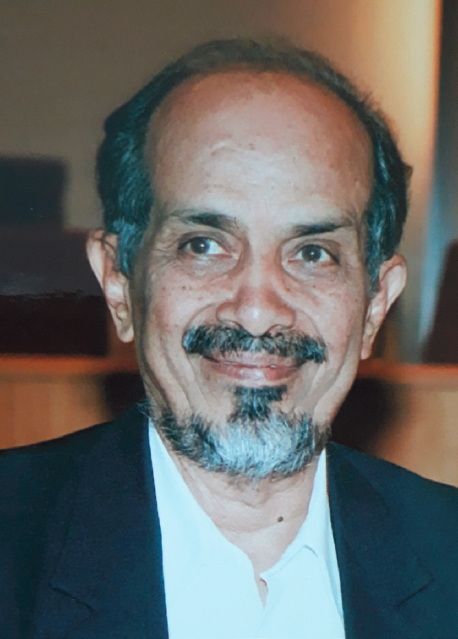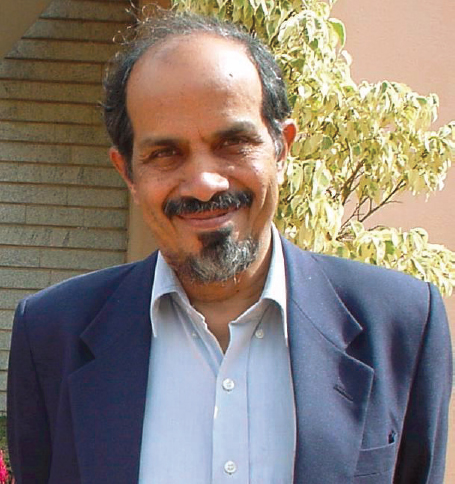RODDAM NARASIMHA
1933–2020
Elected in 1989
“For leadership in the development of aeronautics in India and for many significant contributions to the understanding of fluid flow.”
BY KATEPALLI R. SREENIVASAN
RODDAM NARASIMHA, a star researcher and a thoughtful leader, passed away December 14, 2020, at age 87. He was professionally active almost until the end. His career covered teaching, research, technology development, leadership of learned societies and national institutions, scientific advice to the government at the highest levels, and philosophy and history of science. He will be remembered for the quality of his work, the dignity of his personal interactions, and the inspiration he provided to a number of younger colleagues.
He was elected to the NAE as a foreign member in 1989, in the aeronautical engineering section. His primary areas of research interest were the dynamics of turbulent flows, some of them with a geophysical flavor. Other areas of interest were the structure of shock waves, nonlinear dynamics, and a stochastic theory for airworthiness of aircraft. He was closely associated with several major aerospace projects in India, such as the light combat aircraft and light transport aircraft.
Roddam was born July 20, 1933, and brought up in Bengaluru, where his father taught physics in the Central
__________________
Readers may also enjoy recollections of Roddam’s life and contributions written by many of his colleagues and his daughter, available online by searching ICTS Newsletter VII-II SPL RODDAM NARASIMHA.PDF.
College. Influenced thus, he considered studying physics, but the sociopolitical circumstances of the recently independent India led him instead to pursue a mechanical engineering degree (1953) from the University of Mysore.
As an undergraduate, he happened to visit the Indian Institute of Science (IISc) on an Open Day and saw Spitfire aircraft of World War II vintage (loaned for the occasion by the Indian Air Force) in the quadrangle of IISc’s Department of Aeronautical Engineering. It was love at first sight: he was so fascinated by the design of the aircraft and the complex technology that made it fly that he decided to study aeronautics after his undergraduate degree.
He joined the Department of Aeronautical Engineering at IISc for a diploma and followed it with an associate’s degree (equivalent to a master’s degree), which he completed in 1957. The association with IISc was to last almost all his life. The chair of the department at the time was O.G. Tietjens, a student of Ludwig Prandtl. Satish Dhawan (NAE 1978) had joined the Department of Aeronautical Engineering in 1951, after obtaining his PhD from the California Institute of Technology under Hans Liepmann (NAE 1965). Roddam’s two papers on laminar-turbulent transition, one of which was coauthored with his mentor Dhawan, are still among the most influential fluid dynamics papers to have come from Bengaluru. 1
Inspired by Dhawan, Roddam went to Caltech to pursue his PhD degree in aeronautics with Liepmann. He set up a facility for measuring jet noise in an anechoic chamber, and the findings were published with Erik L. Mollo-Christensen of MIT. Roddam’s theory for free molecular flows using the Boltzmann equation and the Bhatnagar-Gross-Krook (BGK) approximation developed a few years earlier drew immediate attention: Russia had just launched Sputnik and launching a satellite became a national objective in the United States.
___________________
1 Narasimha R. 1957. On the distribution of intermittency in the transition region of a boundary layer. Journal of the Aeronautical Sciences 24:711–12; and Dhawan S, Narasimha R. 1958. Some properties of boundary layer flow during the transition from laminar to turbulent motion. Journal of Fluid Mechanics 3(4):418–36.
Rarefied gas dynamics being an essential approximation of flow around space vehicles, Roddam’s expertise assumed sufficient importance for him to be hired as a consultant while still a student by one of several companies set up to support NASA’s space program. He completed his PhD in 1961 (thesis title: “Some flow problems in rarefied gas dynamics”).
He returned to India in 1962 and joined the IISc Department of Aeronautical Engineering as assistant professor. He quickly became a senior professor, and helped to shape outstanding students and assistants who became experts in their subjects and went on to hold important positions. He also later served as dean of engineering (1980–82) and chair of the Department of Aerospace Engineering (1983–84).
India’s space program was just starting when Roddam returned to IISc from Caltech and his expertise in rarefied gas dynamics was immediately in demand. He also began a program of Monte Carlo simulations of the Boltzmann equation for space applications.
Much of the research those days concerned shock structure and the Boltzmann equation, turbulent bursting, supersonic flows, flow control, wake structure and turbulence modeling, relaminarization (where a turbulent flow goes back to an orderly laminar state), and drag reduction. An ingenious example of how the boundary layer theory could be applied outside of fluid mechanics is his work on the vibration of elastic strings.
In the mid-1970s, an interdisciplinary group interested in the monsoons started nucleating at IISc and eventually led to the creation of the Centre for Atmospheric and Oceanic Sciences in 1982 with Roddam as its leader. He became convinced that the monsoons were an important fluid-dynamical problem to tackle, and central to this effort were convective clouds.
While there was a plethora of studies on cloud microphysics (how cloud droplets form and grow), cloud dynamics remained poorly understood, particularly the consequences of the release of latent heat on entrainment and mixing processes. So laboratory simulation of clouds was attempted and Roddam’s
group finally found a novel way to set up cloud-like plumes in the laboratory. He conceived the idea of a monsoon field program to measure the atmospheric boundary layer properties and develop flux relations relevant to monsoon conditions, and the Monsoon Trough Boundary Layer Experiment (MONTBLEX) was carried out in the Indo-Gangetic Plains in 1990. The data analysis led to a new formulation for surface flux at low winds.
In the meantime, Roddam’s involvement in India’s aeronautical programs was growing. As an example, Indian Airlines had procured Avro aircraft but, at some point, the pilots refused to fly them claiming that the climb rate was too low and the aircraft unsafe to fly. A one-man “Dhawan Committee” aided by a team of advisors from IISc, the National Aeronautical Laboratory (NAL), and Hindustan Aeronautics Limited was formed by the government to examine Avro’s airworthiness. Roddam spent considerable effort in this assessment.
It was thus natural that Roddam would be appointed director of NAL (1984–93). His tenure saw many new initiatives, including the development of light combat aircraft, advanced composites, parallel computers, civilian aircraft, and numerical modeling of the monsoon. His focus was on developing advanced technologies and building products. He steered NAL toward contributing to aerospace projects of the Defence Research and Development Organization and Indian Space Research Organization. He was instrumental in changing the culture in NAL from being satisfied with good publishable results to becoming part of projects with defined deliverables.
When he retired from NAL, Roddam was called on to take charge of the National Institute of Advanced Studies (NIAS) as its second director (1997–2004). NIAS was created for interdisciplinary studies and to enrich leadership in industry, government, and public affairs. He excelled in this new role as well, which gave him the opportunity to hone his dormant interests in history of science and philosophy. He authored and edited several books on metaphysics, consciousness, and history and traditions of Indic science. An interesting theme was
that the notion of proof, sacrosanct in Western mathematics, was supplanted in the Indic tradition by the focus on successful algorithms and computability, often obliterating the proof by which the algorithms were established.
After his term at NIAS, Roddam made the Jawaharlal Nehru Centre for Advanced Scientific Research (JNCASR) his professional home. As chair of its Engineering Mechanics Unit, he oversaw the initial years of its evolution. With less pressure to lead national projects, he returned to his earlier love of research on stability, transition, turbulence, clouds, and the like, and guided students while continuing his interests in philosophy and science policy.
He was an outstanding teacher, both in the classroom and in individual interactions, and a world-class researcher. He cared enormously for quality rather than quantity: For him, writing was an integral part of research because it allowed him to marshal his thoughts rigorously and express them attractively. Over some 65 years he published steadily—about 200 papers, often in the best journals of his field.
His role in various national projects was important as he dispensed advice and wisdom to the highest circles in the country (he was on the advisory council for two prime ministers). Less well known is his dialogue with the US National Academies about India’s nuclear program and security. Altogether, his intellectual impact was remarkable and extensive.
Roddam never shrank from responsibilities to which he was called. In addition to those mentioned above, he served as convenor of the Centre for Atmospheric Sciences (1982–89), president of the Indian Academy of Sciences (1992–94), and founder-president of the Indian Society for Mathematical Modeling and Computer Simulation (1998). He was responsible for getting off the ground the Asian Congress of Fluid Mechanics (1980), and most people are unaware that the institutewide fluid mechanics seminar at IISc was created by him.
In addition, the journal Sadhana, published by the Indian Academy of Sciences, is his creation, and his interest in higher education was behind the inception of the academy’s journal Resonance. He was instrumental in establishing the Ministry
of Earth Sciences in New Delhi. He expressed on more than one occasion the view that academies should not merely recommend action to the government but also constructively do things themselves.
He was recognized nationally and internationally. Among the prestigious visiting positions he held were the Clark B. Millikan Professor and Sherman Fairchild Distinguished Scholar at Caltech and the Jawaharlal Nehru Professor of Engineering at Cambridge University. Besides being elected to the NAE (1989), he was a foreign member of the US National Academy of Sciences (2000) and a fellow of the Royal Society of London, American Academy of Arts and Sciences, Third World Academy of Sciences (TWAS), and all the academies in India. He had the rare distinction of being elected honorary fellow of the Indian Institute of Science. He received the 1974 Shanti Swarup Bhatnagar Prize for Engineering Sciences as well as India’s third and second highest civilian awards, Padma Bhushan (1987) and Padma Vibhushan (2013), and the Gujarmal Modi Award (1990) and Srinivasa Ramanujan Medal (1998) from the Indian Science Congress, among others. Internationally, he received the Fluid Dynamics Award (2000) of the American Institute of Aeronautics and Astronautics, the TWAS Trieste Science Prize (2008), and the 2019 Lifetime Achievement Award for Mentoring in Science established by Nature magazine.
The many honors and recognitions that came his way made no difference to Roddam’s personal qualities that endeared him to so many: easy accessibility to all; the openness with which he interacted with people of all walks of life; abiding interest in intellectual pursuits and love for truth, scientific culture, and scholarship; unprejudiced and disciplined advice provided when sought; clarity of thought in spoken and written words; the personal example he naturally and effortlessly set; genuineness of curiosity; and the inspiration he provided to numerous colleagues. His is a legacy that will endure far into the future.
He is survived by his wife, Dr. Neelima Narasimha, and their daughter, Professor Maitreyi Narasimha.










